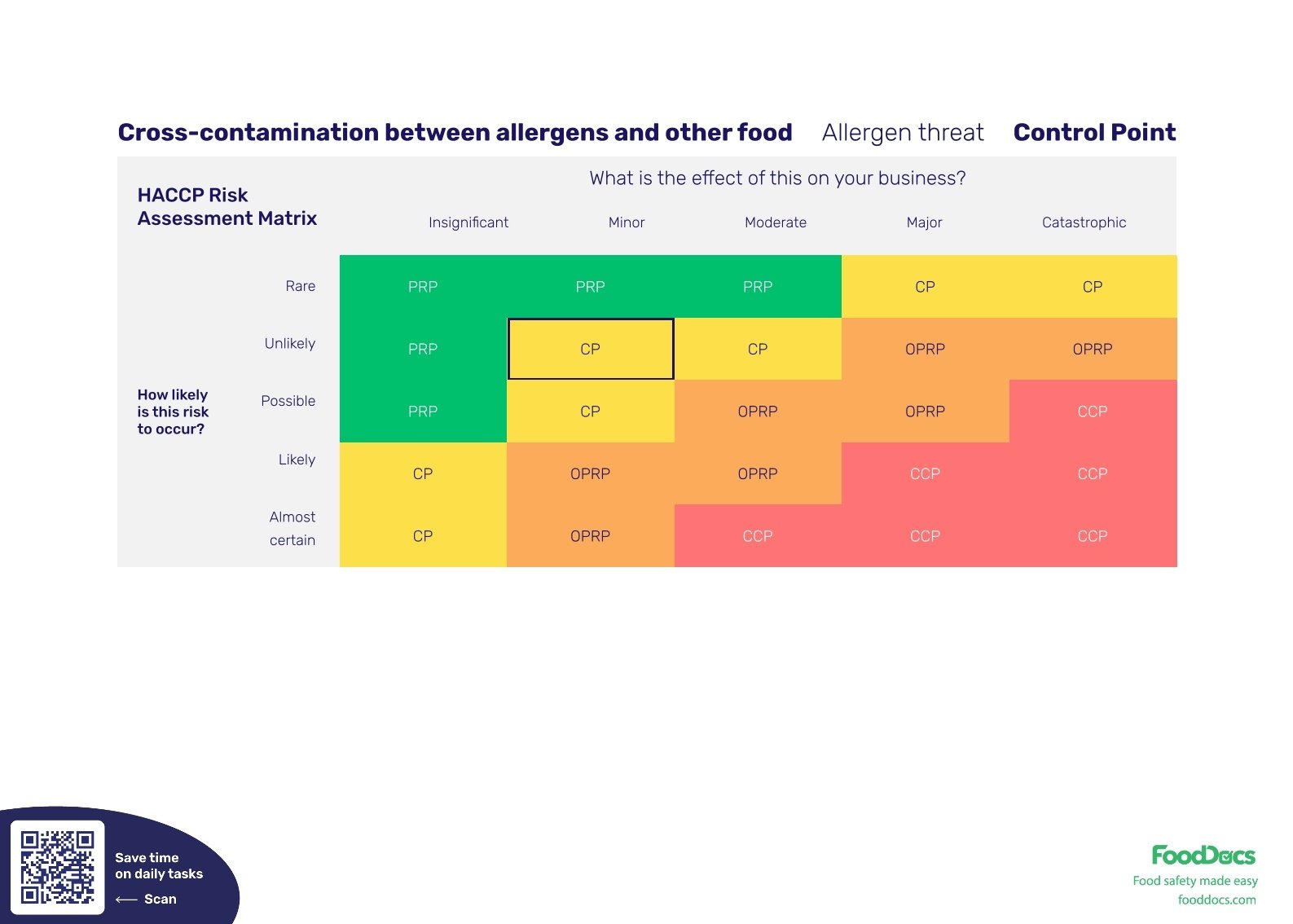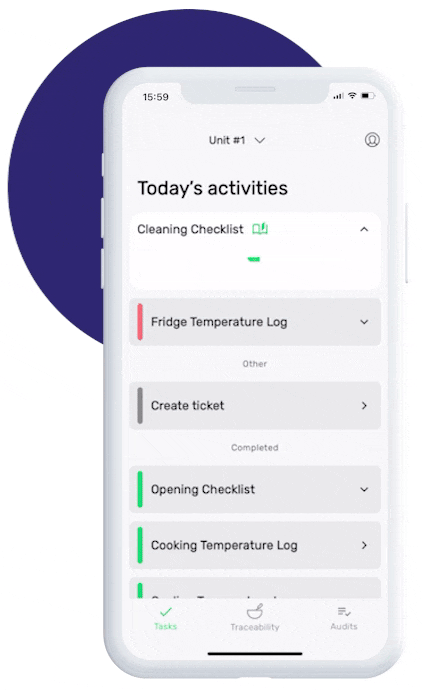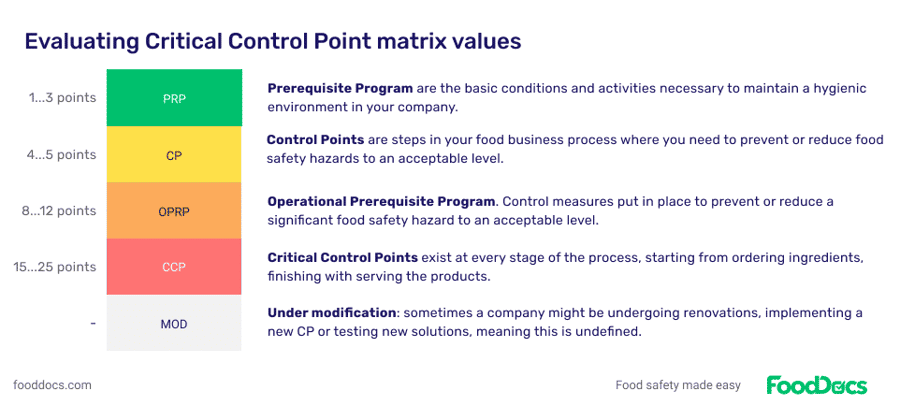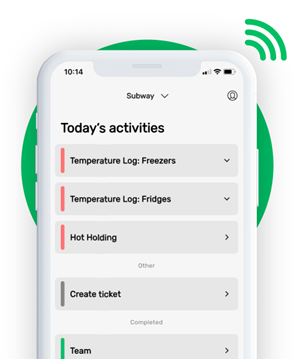DEFINE CRITICAL CONTROL POINT



This is how our Digital Food Safety platform saves 20% of your time on daily tasks:
- Get upcoming task notifications
- Add data into the app
- Check the status of tasks in real-time

When food safety was still handled on paper, I typically spent a couple of hours per day getting the papers and going around checking or completing tasks… Now I can sit down and it's just all there in one place. It takes me 5-10 minutes.
Ruth B.
Store Manager
How does it work?
- Choose the hazard from the dropdown menu;
- Select from the graph how likely is this risk to occur and what is the effect of this on your business;
- Insert your email and download the Matrix and add it to your HACCP plan!
Define critical control point
Defining a critical control point (CCP) in your food operation is perhaps one of the most challenging parts of the HACCP-making process. A huge portion that will contribute to the success of your HACCP plan implementation lies in the correct identification of CCPs. Despite this, it is one of the most essential food safety priorities to keep your business safe from hazards. Using the traditional methods of making a HACCP plan, food safety managers and their teams have to spend hundreds of hours building a complete HACCP plan. A large part of the time spent on this task is spent identifying which is a considered critical control point among your food service operations. The first step in this task is to define critical control point for food safety management.
There are at least two established ways in the food industry to identify CCPs - using a decision tree and a hazard or risk assessment matrix. All identification methods require deep analysis and loads of revision to complete. Proper identification of CC food safety is an essential task if your team wants to create a working HACCP plan. Succeeding steps after CCP establishment will be ineffective with an incorrectly identified CCP. Consequently, the success and safety of your operations heavily rely on the accuracy of your HACCP plan. Building strong and working HACCP food safety systems with a solid foundation is part of the systematic approach and responsibility for food safety assurance of any food service team.
Want to find out the easiest and most accurate way of identifying a CCP? We'll discuss in this article how our free CCP identification tool above can help you.
How does our CCP calculator work?
All values in the matrix correspond to a numerical matrix value. The risk level of the threat is determined by the product of the two values by preset ranges.

What is a critical control point?
We define critical control point as any preventive measure in the food chain that can be applied as a final step to eliminate or control any biological, physical, and chemical hazard to an acceptable level. A CCP is an essential step that can be applied anywhere within the food production journey that addresses previously identified hazards to produce a safe product. Establishing critical control points can be based on existing literature, scientific studies, food safety regulations from regulatory agencies, and form independent expert advice. Additionally, many tools were built to help food establishments define CCPs in their operations for the control of any hazardous food.
Each food business may have a different set of CCPs. The established CCPs depend on the types and nature of operations used in an establishment. They can range from operations like cooking, chilled storage for frozen foods, end-product testing, and even hot holding hot food that controls the biological processes of any microbiological pathogen. Proper identification of hazards is also a vital prerequisite in defining a CCP. Operations that are based on the basic sanitary conditions for clean facilities, food environment, and food contact surfaces are otherwise considered prerequisite programs. Although these operations minimize the risks of hazards, they cannot entirely control or eliminate them to prevent food safety issues.
Who needs to define a critical control point?
A food processing facility that is either required to build a HACCP plan or those that are voluntarily making a HACCP plan will have to identify critical control points in their operations. Each HACCP team must define critical control points in their food production process using established HACCP tools. This phase is the second step in the HACCP plan-making process and will determine the effectiveness of the whole plan. Every food safety team in food facilities will be required to perform this task. Establishing CCPs aims to create the best strategy for controlling any health hazard that may cause adverse effects on the human population from the lack of safety of food products.
Why is it important to define critical control points?
Accurate identification of CCPs is the basis for the effectiveness of every food establishment's HACCP food safety plan. It reduces the likelihood of failure in your management of food safety. The operations established in this action step will be used to control food safety in your food business. Each CCP is specifically assigned to control or eliminate a specific hazard. They are designed after identification and adjacent hazard characterization and analysis.
Defining critical control points allows any of your employees to perform control measures for any breach of food regulatory standards and continuously produce safe food for consumption.
Specifically, CCPs can help you achieve the following:
-
Control food safety. The main objective of CCPs is to control all potential hazards from raw materials to finished products and return them to a safe level. CCPs are designed as the last step to control a hazard before a finished product gets released to the market or served to consumers. When your team properly defines CCP and applies any critical limit correctly, you can ensure that the risk of causing adverse health effects such as foodborne illnesses and diseases to human health is very minimal and that you are only producing wholesome food.
-
Compliance with food safety regulations. In the US, establishing CCPs is part of the many mandatory requirements for the control of food safety. Food safety and government agencies may conduct a visual inspection or audits to verify whether your business is following health codes and is prepared to address potential hazards in your business. Depending on the appropriateness of your CCPs and other areas of the HACCP food safety program, inspectors can present sanctions for poor analysis or provide pointers for improvements based on their visual observations.
-
Increase food standards and customer confidence. With safe food products coming out of your kitchen as a result of properly established CCPs, your business can gain attention from customers. Compliance with basic food safety standards gives you more room and time to improve your services and the quality of your products. Once consumers see and experience your firm commitment and logical approach to food safety and satisfying customer requirements, you can gain their loyalty. This support will significantly help your food business or manufacturing plant.
-
Cost-saving. When high standards for food safety are present, your business saves up on costs that may arise from the consequences of exposure to potential hazards such as foodborne illness cases. Not to mention that there is a potential to face lawsuits when a significant breach in food safety standards occur. Each year, at least $95.2 billion worth of productivity value is lost for low- and middle-income countries due to foodborne illnesses. With properly defined CCPs, it is possible to diminish this estimate and contribute to the productivity of your business.

What else do I need in addition to CCPs?
When defining a CCP, instructions on how, when, and why do you need to do it must be specified. A detailed explanation must be always ready for orienting food handlers. After this step, you would have only covered the second step to building a HACCP food safety plan next to hazard identification and analysis. There are five more process steps to building your comprehensive HACCP food safety plan.
After establishing all of your CCPs, you need to set the following procedure:
- Critical control limits
- CCP Monitoring procedure
- Corrective action procedures
- Verification activities
- Recordkeeping requirements and documentation
Each CCP must have minimum and maximum allowable values to gauge whether the process is still within standards or has already breached the acceptable levels. Additionally, every CCP must also be properly monitored to ensure food safety compliance. These tasks mean that you will have multiple monitoring forms as an accurate record to ensure that your HACCP system is working well.
These steps are all part of the 7 principles of HACCP. They help ensure the safety of your products and protect public health by preventing loss of control of food safety hazards.
CCPs must be correctly established and followed. One of the major causes of any foodborne illness is the improper application of CCP such as cooking which can be remedied with the proper definition. Proper cooking ensures that any biological hazard such as the food safety risk of contamination from enteric pathogens is eliminated. Additionally, proper conditions of storage with temperature control can become a CCP that controls the growth of bacteria and other pathogenic microorganisms in any finished product.
How to define critical control point?
The first basic rule in defining a CCP is that the step must be essential in preventing or eliminating a food safety hazard. If other succeeding steps could prevent a hazard, then the process may not be a CCP. In addition, other criteria such as the probability of occurrence and the degree of resulting damage that a food safety hazard may cause are used to determine a CCP.
In the food industry, the two most widely known methods are recognized to define a critical control point in your food system. These methods include the use of the following tools:
- HACCP decision tree. This tool uses a set of definitive questions to determine whether a selected operation is a CCP or not. These questions are always answerable by a yes or no and will help you support your judgment for CCP establishment. A Hazard Analysis Critical Control Point decision tree analyses each operation based on its immediate need and whether there is a succeeding step to control the hazard or none. It is used after hazard analysis and requires the use of a comprehensive process flow chart diagram of your food operations which is the basic framework of your system.
- Hazard matrix. This tool bases the risk management decisions of whether an operation is a CCP or not on the likelihood of occurrence and the adjacent degree or level of damage that a hazard can cause. Basically, the steps of risk assessment matrix evaluate the hazard to determine an operation that is appropriate to eliminate or control it. This tool uses a visual representation of the control parameters and numeric standards for risk characterization and to create a food safety risk analysis.
Both of these tools guarantee to help you identify which steps in your operation are critical to controlling food safety hazards. You can learn more about the two CCP identification tools in this comprehensive article about the decision tree and hazard matrix that we made. The problem with these two tools is that their use entails several steps and can be quite confusing. Your HACCP team needs supervision from someone with very deep knowledge about food safety risks and might even need further research and literature. Luckily, FoodDocs has come up with an innovative digital solution for this problem.
The easiest way to define a CCP
In accordance with our objective to make food safety accessible to everyone, our food safety team at FoodDocs has come up with a free tool that can help you define critical control point in your operations. Using an established hazard matrix, we have made a free tool that allows you to identify the need for a critical control point based on a predefined food safety hazard. Our system has listed some of the most relevant biological, chemical, and physical hazards in the food industry. These hazards include microbiological hazards, physical hazards, chemical hazards, allergens, attacks on food (terrorism), and nutritional hazards.
Using our free tool is super easy and reliable, it only takes three simple steps:
- Choose a hazard from the dropdown menu;
- Select from the graph how likely is this risk to occur and its potential degree of effect on your food company.
- Insert your email then download the Matrix and add it to your HACCP plan.
Based on the hazard and the selected parameters, our system will automatically show you to which category of control operation it belongs. If a specific hazard that you are looking for is not present, you can choose "Others" from the dropdown menu and manually type the hazard of concern. The suggested operations vary among the following:
- Prerequisite programs (PRP) - include standard operating procedures, good manufacturing and employee practices, and sanitary design principles for the maintenance of safe basic conditions and prevention of multiplication of pathogens.
- Control point (CP) - is any food handling process that can reduce the level of food safety hazards but not necessarily eliminate them.
- Operational prerequisite programs (OPRP) - are sets of very specific control measures targeting a particular food safety hazard.
- Critical control point (CCP) - is any final food processing procedure used to control or eliminate any food safety hazard in your operations.
An operation is regarded as a CCP should the effect have a moderate probability of occurrence to catastrophic. Using this tool, you can help your team easily determine CCPs in your whole food safety operations with accuracy. You can reduce the significant amount of time that you will be spending on determining CCPs and reduce the chances of conducting a frequent review and many revisions with your identified list of operations. The best part about this tool is that it's completely free and accessible to everyone.
Quick summary of CCP topics
Are you still finding it hard to understand how to define critical control point? Here is a list of some of the most frequently asked questions regarding this topic and some quick answers:
Which is an example of a critical control point?
One of the most evident critical control points is cooking raw materials to the correct internal temperature. Targeting the recommended food temperature is usually the last process step and opportunity to eliminate hazards before the finished food item reaches a consumer.
What are the critical control points in food preparation?
Four of the most prominent critical control points in food preparation include the following:
- Cold storage
- Heat process
- Hot holding
- Cooling
Examples of CCPs may vary depending on the nature of every food establishment. Read more about different critical control point examples.
What is the difference between a control point and critical control point?
Control points are preventive control measures for different types of hazards but may not be critical to eliminating the risk, whereas a critical control point is an intrinsic step to ensure that the hazard in cooked food is controlled and will not cause any foodborne illness. Ideally, there is no other subsequent step to minimize the imminent food safety risk of hazards after a CCP.
How are critical control points determined?
Determining a CCP is based on accurately analyzed hazards and with the help of tools such as a decision tree or food safety risk assessment matrix.
Digital solution to get your HACCP done in 1 hour
Even with the help of a risk assessment matrix, establishing critical control points can take so much of your employee's time. Not to mention that your CCPs are dependent on proper identification of hazards and creating a simple but detailed flow chart diagram of your operations. After the initial validation, you still need to apply critical limits, procedures for monitoring, and other basic principles of HACCP for a proper food safety management system.
As a food safety supervisor, the management of food safety through creating and implementing a HACCP food safety plan takes anywhere between 1 to 12 months. Several revisions from your initial plan will surely follow after the initial stages of your implementation. You can hire a food safety professional to help you speed up the process but this route can cost you anywhere between $6 to $500 per hour of service. What if there was a way to cut this whole process and automatically get a comprehensive and complete HACCP plan in just 1 hour?
At FoodDocs, our built-in HACCP plan builder software can help you create all of the most important sections of your HACCP plan in an hour. That's 500x faster than the traditional processing method of making your HACCP plan! What's even greater is that the process would only require you to answer a few basic series of questions that will help us understand your entire manufacturing process. Using artificial intelligence and a machine learning program, our system will automatically create a comprehensive digital HACCP plan for you. You can even customize the most important sections to make the plan perfectly fit for your food business.
With our built-in HACCP plan builder, you can get the following in just 1 hour:
- Basic flow diagram of your food safety operations
- Properly identified and complete analysis of hazards
- Established hazard analysis critical control points
- Proper critical limit for every CCP
- Digital CCP monitoring procedures and records
- Established corrective action plan
- Comprehensive verification procedures
- Record-keeping and documentation procedures
With our HACCP builder software, you can save up to 120 hours of work from making your HACCP plan and save a significant amount of money. Our system is 15x cheaper than the average price for creating a HACCP plan. With this system, you can leave the identification of CCPs to our software, and all that you have to do is verify the information and implement the plan right away.
The HACCP plan that our system generates for you is backed by an extensive pool of food safety knowledge from credible references and the experience of top-notch food safety experts. If you ever need to add more information, your automatically generated HACCP plan can accommodate customizations.
Want to experience a fast system that generates your HACCP plan in just 1 hour? We offer a free, 14-day trial where you can build your digital HACCP plan.












